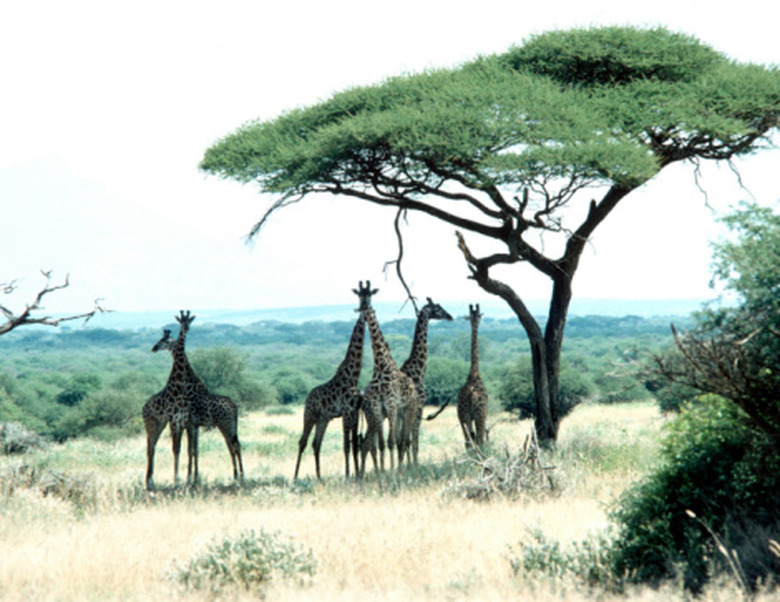Facts About Umbrella Thorn Acacia
One of the most widely distributed trees across Africa, the umbrella thorn (Acacia tortilis) grows well in arid regions across the savanna and seasonally moist deserts into the Middle East, too. Romantic safari photographs often reveal the distinctive flat-topped and umbrella-like silhouette of this tree with a setting sun in the distance. Umbrella thorn trees play a key habitat and food source role for animals and serve as a fuel for humans.
Tolerances
The umbrella tree tolerates extensive summertime heat and drought as well as dry, saline and alkaline soils. Across its native Africa and southwest Asia, it endures daytime temperatures well over 100 degrees Fahrenheit but also occasional bouts of seasonal nighttime cold in the 32 to 45 degree range. Frost kills young seedlings but mature trees fare well with upper leafy branches several feet above the coldest air pooling at the soil surface below. It survives on as little annual precipitation as 1 1/2 inches to as much as 47 inches.
- One of the most widely distributed trees across Africa, the umbrella thorn (Acacia tortilis) grows well in arid regions across the savanna and seasonally moist deserts into the Middle East, too.
Features
In extremely arid conditions, umbrella thorn remains a scrubby bush. Typically it develops multiple trunks that spread to support a wide, umbrella-shaped canopy of thorny branches and compound leaves, each made up of up to 30 leaflets. The fragrant white to pale creamy yellow pea blossoms open in early summer and later yield spiral seed pods. The pods mature pale brown and do not split open but fall coiled and enclosed to the ground.
Fauna Relationships
As one of the only trees in the arid plains of Africa and southwestern Asia, various birds find refuge in the shade and cover of the umbrella thorn. Young seedlings make a meal for various grazing animals on the African savannas and the fallen seed pods are favored by elephant, kudu, impala and rhinoceros. Elephants also eat the bark on mature trees while vervent monkeys, giraffes and baboons consume immature green seed pods dangling from branches.
- In extremely arid conditions, umbrella thorn remains a scrubby bush.
- As one of the only trees in the arid plains of Africa and southwestern Asia, various birds find refuge in the shade and cover of the umbrella thorn.
Economic Benefits
Felled trees provide fuel for cooking among peoples of arid landscapes. The wood may also be made into fences, wagon wheels or furniture. Both the leaves and seed pods provide food to domesticated grazing animals. In the Rift Valley, bark is made into string. The tree gum is edible, too. Across marginal areas of Africa where deserts are expanding, planting umbrella thorn trees affords people an effective strategy to limit the movement of sand dunes and the desertification of agricultural areas in seasonal drought.
